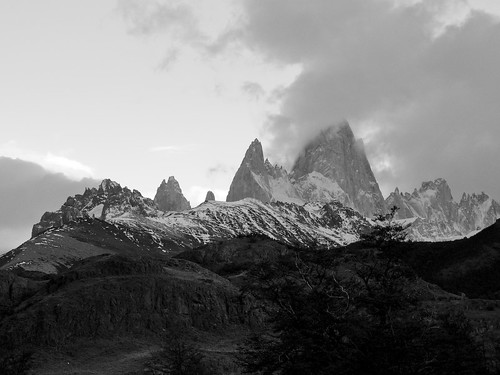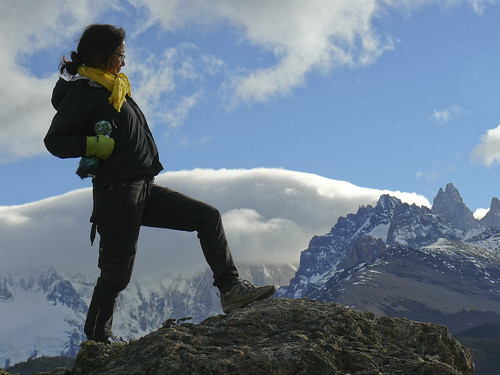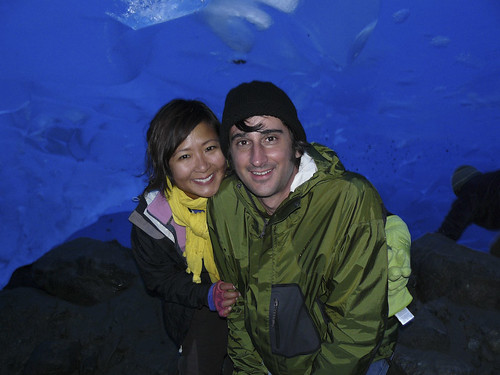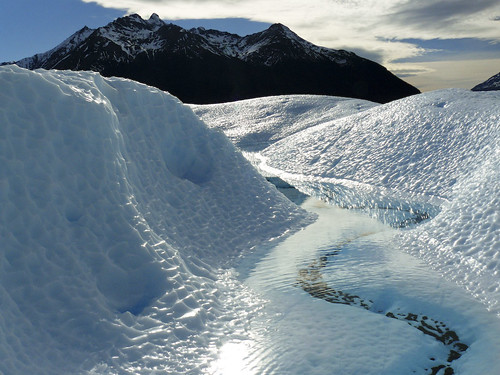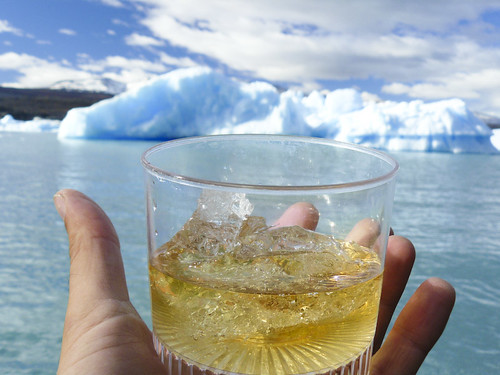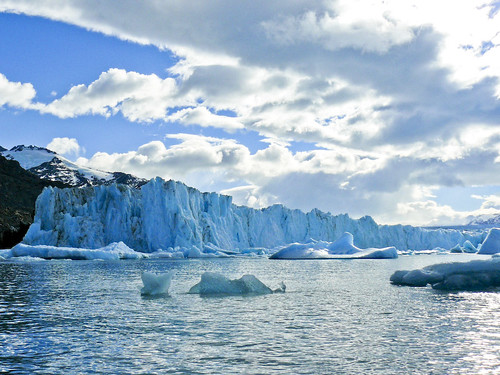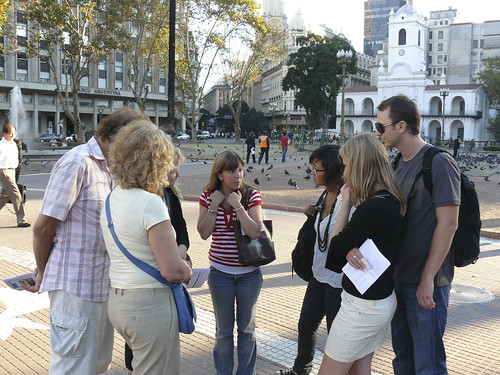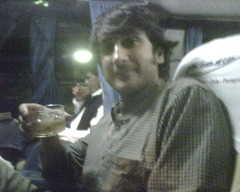Our next stop in Patagonia was El Chalten, home of the famous Fitzroy mountain range, which seemed perpetually covered with clouds while we were there. It also looks a lot colder in the pictures than it really was, but considering we haven’t been in cold weather in well over a year, it still felt pretty cold to us. Of course that didn’t stop Christine from attempting to climb to the summit
Archive for the ‘Argentina’ Category
El Chalten
Monday, May 5th, 2008ice box
Sunday, May 4th, 2008trekking on the Perito Moreno glacier
Sunday, May 4th, 2008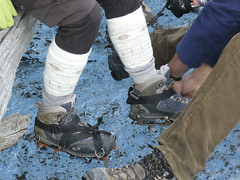 The next morning we set off early for our “Big Ice” trek on the Perito Moreno glacier. The Perito Moreno glacier is only one of three glaciers in Patagonia that is not retreating. Depending on the time of year, the glacier is continually advancing and/or retreating. Occasionally we would hear a loud cracking sound, similar to that of thunder, followed a chunk of ice falling off the glacier, splashing into the water. Quite an amazing experience.
The next morning we set off early for our “Big Ice” trek on the Perito Moreno glacier. The Perito Moreno glacier is only one of three glaciers in Patagonia that is not retreating. Depending on the time of year, the glacier is continually advancing and/or retreating. Occasionally we would hear a loud cracking sound, similar to that of thunder, followed a chunk of ice falling off the glacier, splashing into the water. Quite an amazing experience.
For our trek, we started hiking along the mountainside for an hour alongside the glacier. Before stepping onto the glacier, we had crampons securely fastened to our hiking boots. The trek on the glacier was about 4 hours, and it was one of the highlights of my trip. The crampons ensure a strong grip in the ice even when going uphill or downhill. They made crossing on the glacier surprisingly easy, with the satisfying crunch of ice under-foot.
I thought the boat ride was amazing, but even there you can’t see the details of the glacier…there are streams and pools of water running throughout the glacier, along with cracks and crevasses filled with water. Different objects on the glacier (such as rocks, leaves, branches), absorb the sun at a faster rate, creating a depression (called cryocones), which then creates small natural pools and streams that continue to melt at a faster rate than the glacier. A small pebble might be responsible for 30 foot deep pool.
Mmmmm… Glaciers taste good
Sunday, May 4th, 2008cruising around the glaciers
Sunday, May 4th, 2008After a week of taking Spanish classes and eating bife de chorizo in Buenos Aires, we flew south to El Calafate to see the mountains and glaciers of Patagonia. Early the next day, even before sunrise we departed by boat from Bandera Port to explore the nearby glaciers–Upsala (the largest in the region), Spegazzini (with the highest front wall @ 400ft) and Agassiz.
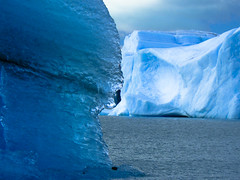 The glaciers in Patagonia are centennial glaciers, existing in the last hundred years, rather than the millennial glaciers of Antarctica (thousands of years old). The glaciers are formed in the Andes mountains–as snow accumulates in the valleys between the mountains, over time the snow becomes compact, forming into ice. The icefields of Patagonia are the source of the world´s third largest freshwater source.
The glaciers in Patagonia are centennial glaciers, existing in the last hundred years, rather than the millennial glaciers of Antarctica (thousands of years old). The glaciers are formed in the Andes mountains–as snow accumulates in the valleys between the mountains, over time the snow becomes compact, forming into ice. The icefields of Patagonia are the source of the world´s third largest freshwater source.
By boat, we were pretty close to the glaciers and icebergs, able to see clearly the beautiful shades of blue reflecting off the sun along with the different textures of each glacier. It was spectacular. At one point the crew, pulled out a chunk of ice floating in the water so we could drink our Nacional whiskey with fresh glacier ice.
House of Peña
Saturday, April 26th, 2008People in Argentina don’t sleep. Restaurants don’t even open their doors until 8PM, and even then most people don’t go out to eat until 10. Going to bed on a full stomach isn’t healthy, so luckily clubs don’t get busy until 2 or 3 and go until the morning. Needless to say, this lifestyle didn’t quite fit into our schedule of getting up for our 9AM Spanish class. Since our class ended on Fri. we decided to sample some Argentinian nightlife. After the obligatory 11PM steak, we went to Peña Los Cardones. Peñas are grass-roots get-togethers showcasing popular folklore – which usually means locals meeting up for traditional-style dancing and music over drinks. In German beer hall fashion, wooden tables dominate the floor space accommodating the lively crowd taking in a hearty share of live folk music and Quilmes brew (the domestic beer in Bs As). The performance part of the evening lasts until 2AM, culminating in a big sing along on stage.
[youtube]http://www.youtube.com/watch?v=hO5mFMHQqKQ[/youtube]
Then each table has a guitar and a songbook and everyone spends the rest of the night singing traditional folk songs
[youtube]http://www.youtube.com/watch?v=EJp0Ky3GccA[/youtube]
Spanglish
Friday, April 25th, 2008Since my last extended period of being in a Spanish speaking country didn’t produce much results, we decided to enroll in a few Spanish classes during our week in Buenos Aires. The morning class was more traditional, in a classroom setting and the afternoon class was a combination, tour/language class where we went around the city to different areas and learned some practical Spanish. We had to go to the bus station, the supermarket and restaurants and try to practice what we learned. It was pretty fun and an interesting way to see the city. Unfortunately Argentinian Spanish is a bit odd so it’s kind of like being taught to have a speech impediment to the rest of the Spanish speaking world, but at least I can now ask where the bathroom is.
Ojo de bife
Friday, April 25th, 2008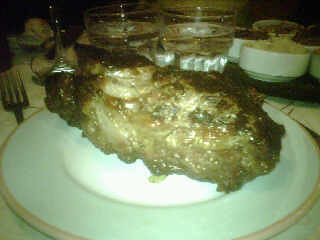
Argentina is known for its delicious beef, and by looking at this photo how could you have any doubts?? If you can believe, this is the rib eye steak Mike ordered at La Cabrera in Buenos Aires. My guess is that it was 2 pounds of beef, maybe more. It was big enough to measure in terms of volume/cubic inches– that’s how thick and crazy big it was. My order of the bife de chorizo (the rump steak) was also a giant serving and tasted even better than the ribeye.
If I knew how large the portions were we would have shared one steak, especially since we sat down to eat around 10:30PM (which is the typical time Argentines eat).
another long, long bus ride
Thursday, April 17th, 2008From Encarnacion, Paraguay we crossed into Posadas, Argentina then took another bus onto Buenos Aires. A 12 hour overnight bus ride became a 20hour bus ride. Fortunately, we were traveling in lido class (first class) with fully reclining seats, movies, hot meals and whiskey to wash away the hours.
For weeks now, the farmers in Argentina have been striking against the increased export taxes the government recently approved. Their strikes include closing down major roads and highways, leaving cars and buses sitting on the road for hours on end. Tuesdays are their day to strike. Last week Tuesday, the only access road to Iguacu Falls was closed down, preventing us from accessing the falls from Argentina. This week Tuesday we ended up sitting on the highway leading into Buenos Aires adding 8 hours onto an already long bus trip. Although the delays are annoying, I’d much rather deal with a road block than the reality of restaurants running out of beef in Buenos Aires.
